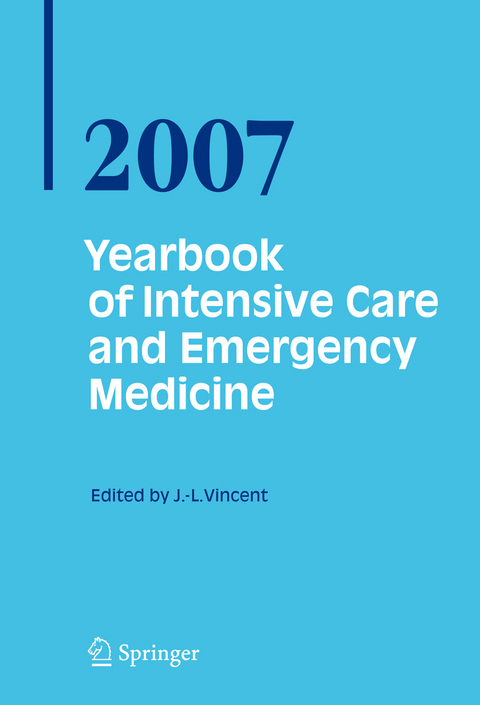
Yearbook of Intensive Care and Emergency Medicine 2007
Springer Berlin (Verlag)
978-3-540-49432-4 (ISBN)
- Keine Verlagsinformationen verfügbar
- Artikel merken
Biomarkers.- The Diagnosis of Sepsis: The Present and The Future.- Procalcitonin: Nice to Know, Need to know, or Needs Further Research?.- Diagnostic and Prognostic Value of Hormokines as Biomarkers in Severe Infections.- Novel Biomarkers and the Outcome from Critical Illness and Major Surgery.- Molecular Approaches to Detection of Bacteria in Critical Care Patients.- Sepsis and Infection: Management.- Understanding and Optimizing Outcome in Neonates with Sepsis and Septic Shock.- Effects of Vasoactive Agents on the Gastrointestinal Microcirculation in Septic Shock.- Hemodynamic Effects of Activated Protein C in Septic Shock.- Adrenomedullin in the Treatment of Cardiovascular Dysfunction and Sepsis.- Antioxidants for the Treatment of Endothelial Dysfunction in Critical Illness.- Plasma Cortisol: Time to Look Deeper?.- Glucose Control and Monitoring in the ICU.- Severe Lung Infections.- Current Concepts of Severe Pneumococcal Community-acquired Pneumonia.- Respiratory Syncytial Virus (RSV) in the Pediatric Intensive Care Unit.- Pneumocystis Pneumonia in Non-AIDS Immunocompromised Patients.- Mechanisms of Organ Dysfunction.- The Role of Neutrophil-Derived Myeloperoxidase in Organ Dysfunction and Sepsis.- Are Mitochondria Responsible for Improved Outcomes in Recent Studies?.- The Impact of Chronic Disease on Response to Infection.- Immunomodulatory Effects of General Anesthetics.- Critical Illness Stress-induced Immune Suppression.- Transcription Factors and Nuclear Cofactors in Muscle Wasting.- Organ Dysfunction in the ICU: A Clinical Perspective.- Lipids.- Sphingolipid Metabolism in Systemic Inflammation.- Statins in Sepsis and Acute Lung Injury.- Potential Mechanisms by which Statins Modulate the Development of Acute Lung Injury.- Acute Lung Injury.- Matrix Metalloproteinases in Acute Lung Injury.- The Role of Vascular Endothelial Growth Factor in Lung Injury and Repair.- Cell Regeneration in Lung Injury.- The Extracellular Matrix of the Lung: The Forgotten Friend!.- Mechanical Ventilation.- Advances in Translaryngeal Tube Technology.- Is One Fixed Level of Assist Sufficient to Mechanically Ventilate Spontaneously Breathing Patients?.- Patient-ventilator Interaction During Non-invasive Ventilation with the Helmet Interface.- Protective Ventilation in Respiratory Failure.- Dynamic Lung Imaging Techniques in Mechanically Ventilated Patients.- Can We Protect the Lung from Acute Injury?.- Rationale for High-Frequency Oscillation as a Primary Lung-Protective Mode in Patients with ALI/ARDS.- The Role of Protective Ventilation in Cardiac Surgery Patients.- Alveolar Pressure/volume Curves Reflect Regional Lung Mechanics.- Cardiovascular Topics.- Cardiovascular Surgery in the Aging World.- Intensive Care Unit Arrhythmias.- Diastolic (Dys)Function in Sepsis.- Autonomic Dysfunction: A Relevant Component in Multiple Organ Dysfunction Syndrome.- Hemodynamic Monitoring.- The Use of Hemodynamic Monitoring to Improve Patient Outcomes.- Using Mathematical Models to Improve the Utility of Quantitative ICU Data.- The Meaning of Hemodynamic Monitoring in Patients with Shock: Role of Echocardiography.- Transpulmonary Thermodilution for Advanced Cardiorespiratory Monitoring.- Using Heart-Lung Interactions for Functional Hemodynamic Monitoring: Important Factors beyond Preload.- Diagnosis of Central Hypovolemia in a Spontaneously Breathing Patient.- Assessment of Fluid Responsiveness in Spontaneously Breathing Patients.- Passive Leg Raising.- Extravascular Lung Water Measurement.- Intravenous Fluid Therapy.- Fluid Management in Sepsis: Colloids or Crystalloids?.- Balanced Volume Replacement Strategy: Fact or Fiction?.- Renal Failure.- Cystatin C as a Marker of Renal Function in Critically Ill Patients at Risk for or with Acute Renal Failure.- Adjustment of Antimicrobial Regimen in Critically Ill Patients Undergoing Continuous Renal Replacement Therapy.- Abdominal Pathologies.- Abdominal Compartment Syndrome.- Gut Absorption Capacity in the Critically Ill.- The Liver.- Critical Illness and the Hepatic Microcirculation: A Review.- The Hepatic Response to Severe Injury.- The Management of Liver Trauma.- The Pathology and Management of Intracranial Hypertension in Acute Liver Failure.- Neurological Issues.- Continuous EEG Monitoring in the ICU.- The Acute and Chronic Management of Large Cerebral Infarcts.- Cooling Therapies after Neuronal Injury: Direct Brain Cooling and Systemic Hypothermia.- Non-traumatic Subarachnoid Hemorrhage.- Promising Concepts in Subarachnoid Hemorrhage.- Nitric Oxide Metabolism after Traumatic Brain Injury.- Modulation of Blood Pressure in Traumatic Brain Injury.- The Delirious Patient in the ICU.- Management of Burns.- Emergency Room and Acute Care of the Critically Ill Burned Patient.- Early Manipulation of Metabolic Changes due to Severe Burns in Children.- Antithrombin in Burn Trauma.- Hematological Alterations.- The Critically Ill Red Blood Cell.- Red Blood Cell Transfusion in the Pediatric ICU.- Thrombocytopenia in Intensive Care Patients.- Point-of-care Coagulation Monitoring: Current Status of Viscoelastic Techniques.- Monitoring of Hemostasis in Emergency Medicine.- Oral Anticoagulant Overdose and Bleeding Risk.- Does Sex Make a Difference?.- Insight into the Mechanism of Gender-specific Response to Trauma-hemorrhage.- Sex-Related Differences in Response to Global Ischemic Insult and Treatment.- Influence of Gender on Outcome of Severe Sepsis.- Prognosis and Long-term Outcomes.- The Changing Prognostic Determinants in the Critically Ill Patient.- Chronic Critical Illness.- To be or not to be ... Vegetative.- Quality and Management.- Intermediate Respiratory Care Units.- The Impact of Noise in the Intensive Care Unit.- Alarms: Transforming a Nuisance into a Reliable Tool.- Ethical and Legal Dilemmas in Accessing Critical Care Services.- Emergency Care for the VIP Patient.- Brain Death: Compliance, Consequences and Care of the Adult Donor.- Disasters.- Update on Avian Influenza for Critical Care Physicians.- Critical Care Pandemic Preparedness Primer.- Pathobiology of Blast Injury.- Personal Reflections on Emergency Preparedness and the Response to A Major Natural Disaster: Hurricane Katrina.
| Erscheint lt. Verlag | 15.3.2007 |
|---|---|
| Reihe/Serie | Yearbook of Intensive Care and Emergency Medicine |
| Zusatzinfo | XXXII, 1040 p. 192 illus. |
| Verlagsort | Berlin |
| Sprache | englisch |
| Maße | 170 x 242 mm |
| Gewicht | 1630 g |
| Themenwelt | Medizin / Pharmazie ► Medizinische Fachgebiete ► Intensivmedizin |
| Medizin / Pharmazie ► Medizinische Fachgebiete ► Notfallmedizin | |
| Sozialwissenschaften | |
| Schlagworte | Emergency Medicine • hemodynamic monitoring • Intensive care unit • Intensivmedizin; Handbuch/Lehrbuch • Internal Medicine • Notfallmedizin / Akutmedizin; Handbuch/Lehrbuch • Notfallmedizin; Handbuch/Lehrbuch • respiratory failure • Sepsis |
| ISBN-10 | 3-540-49432-4 / 3540494324 |
| ISBN-13 | 978-3-540-49432-4 / 9783540494324 |
| Zustand | Neuware |
| Haben Sie eine Frage zum Produkt? |
aus dem Bereich


